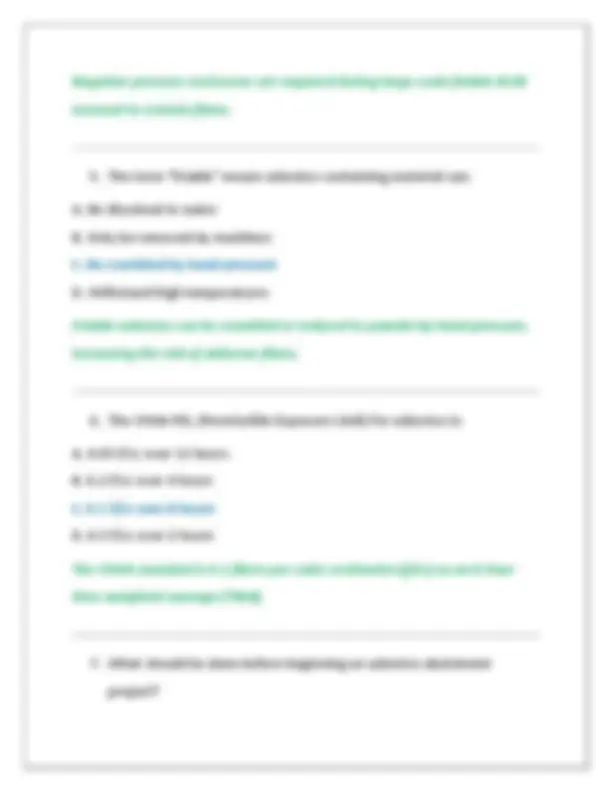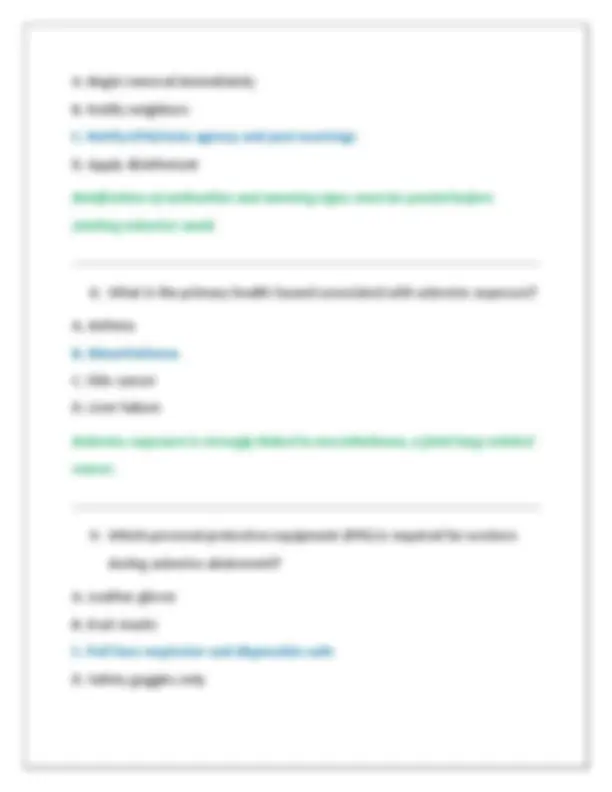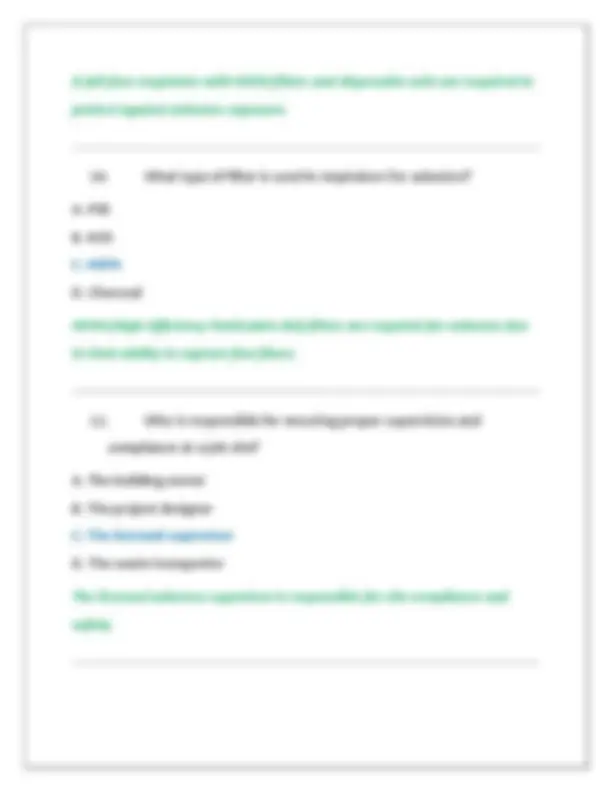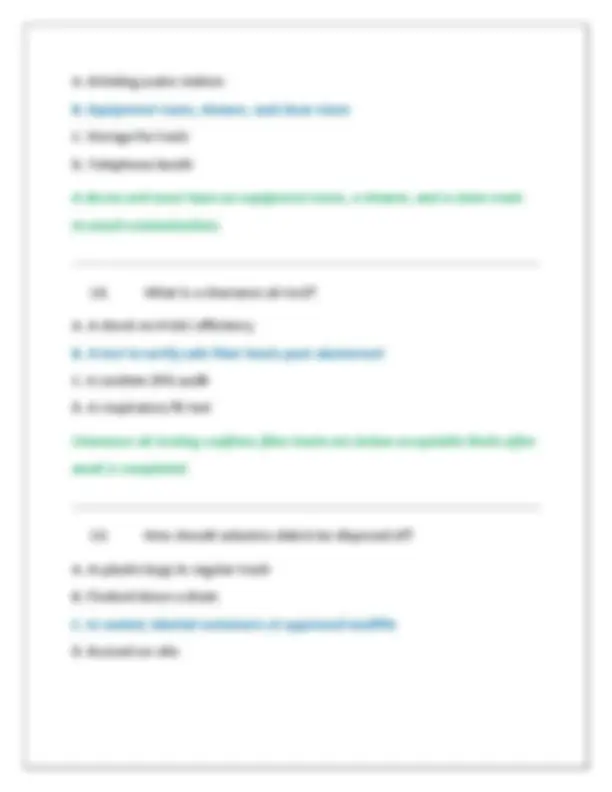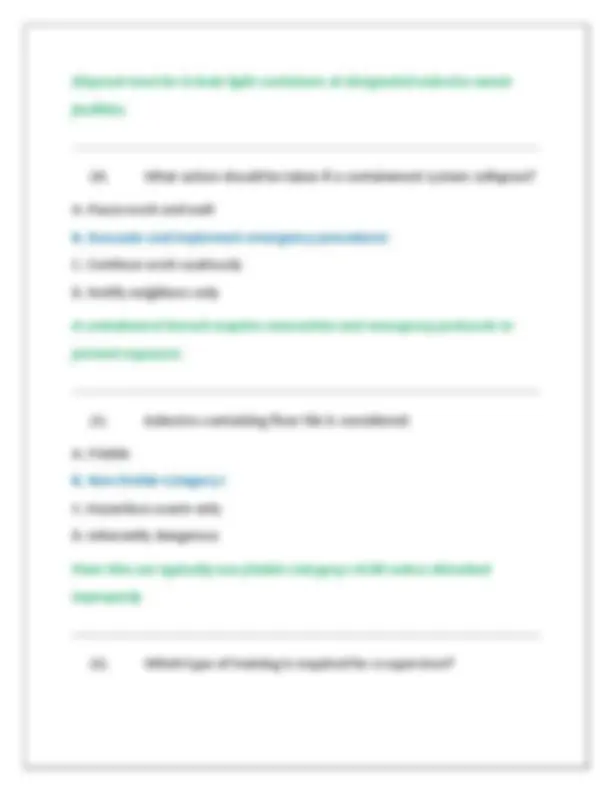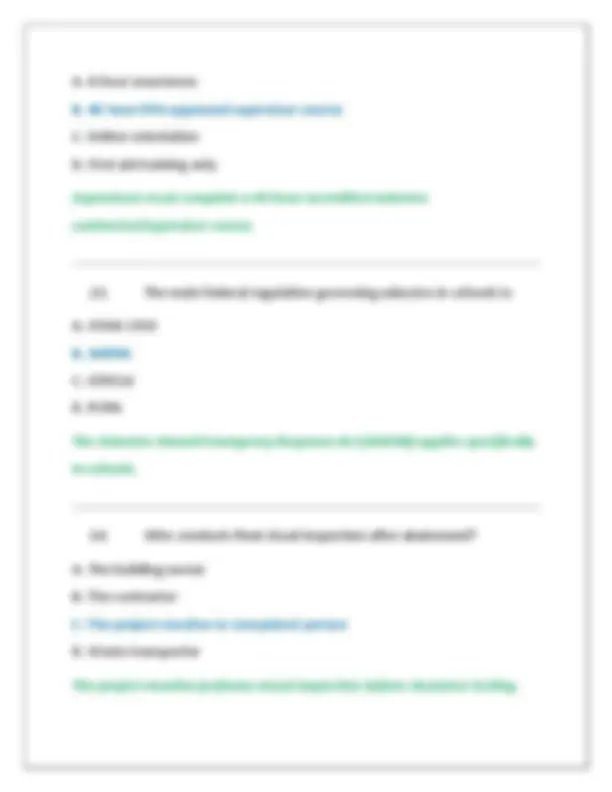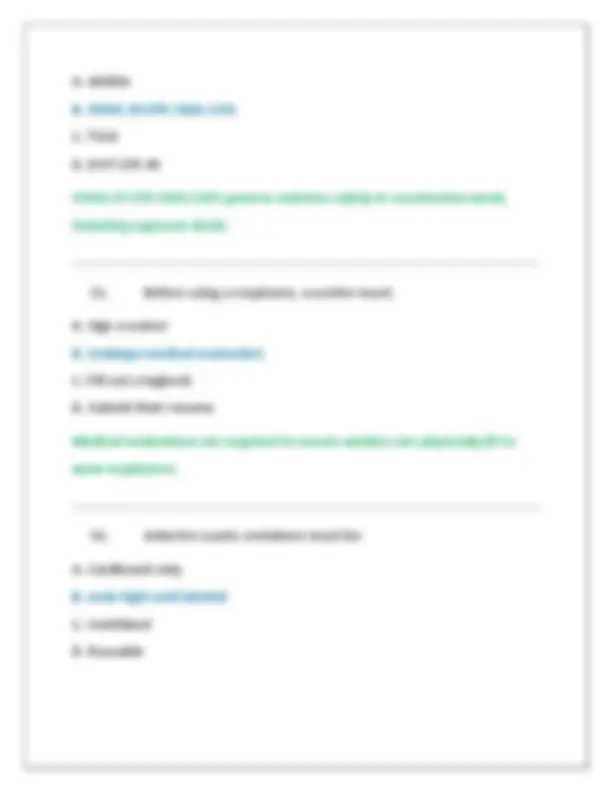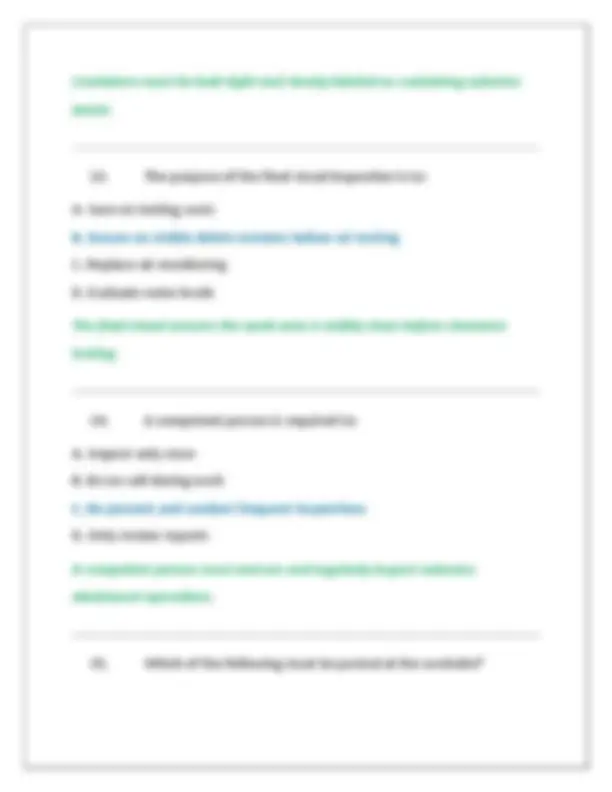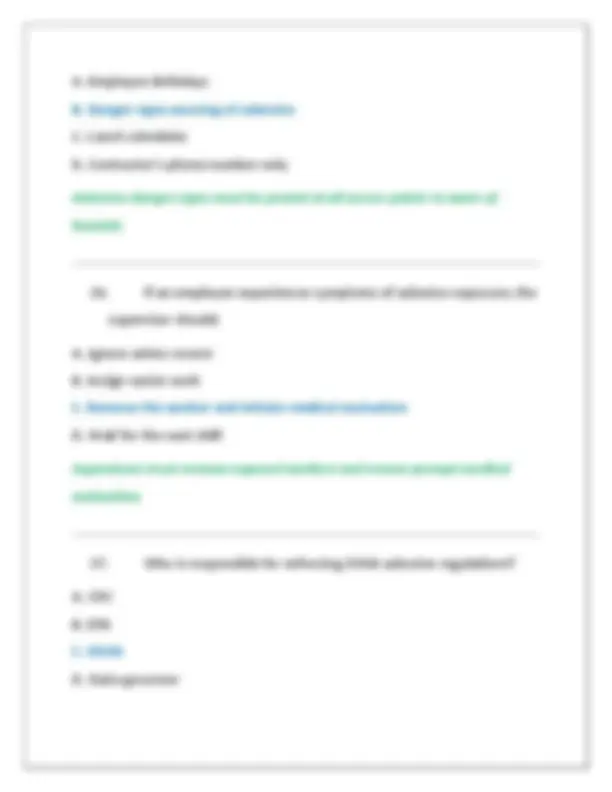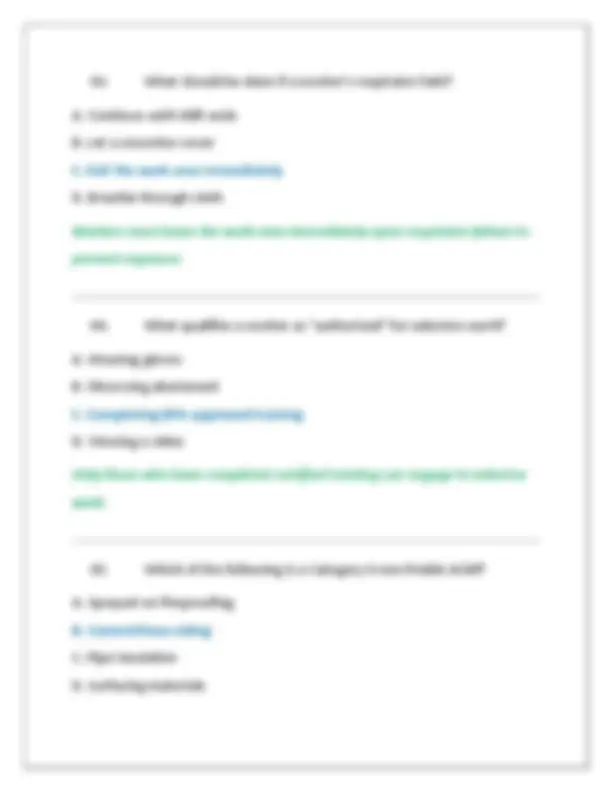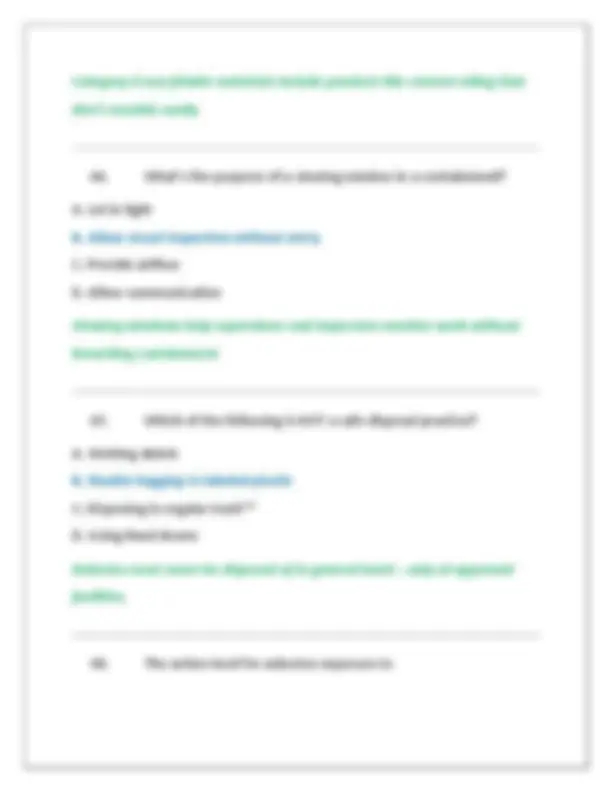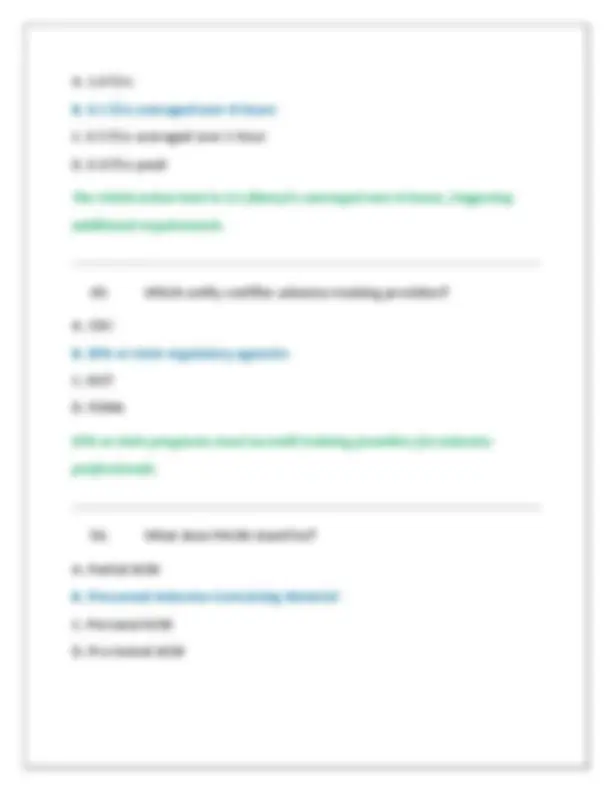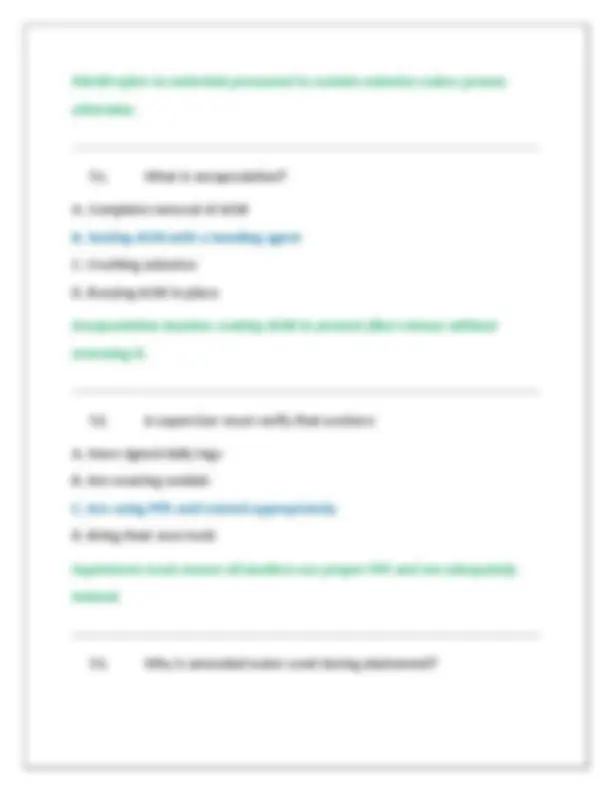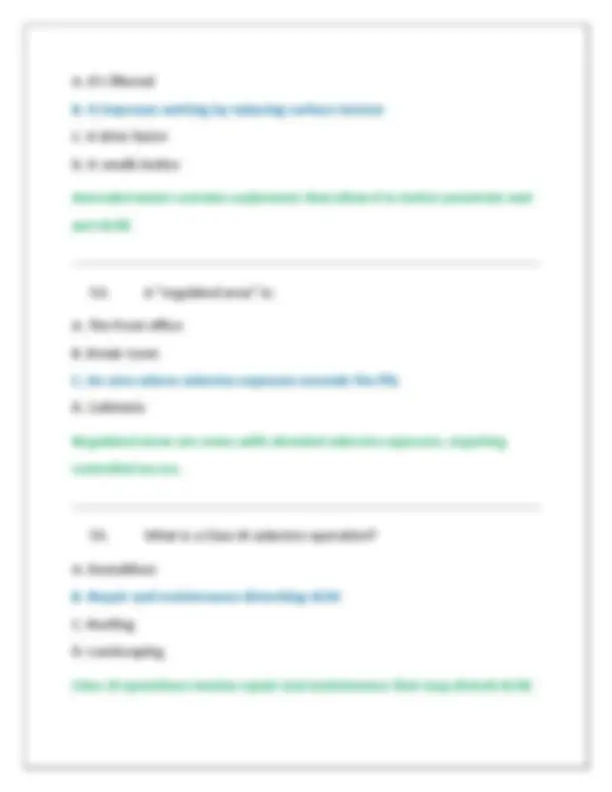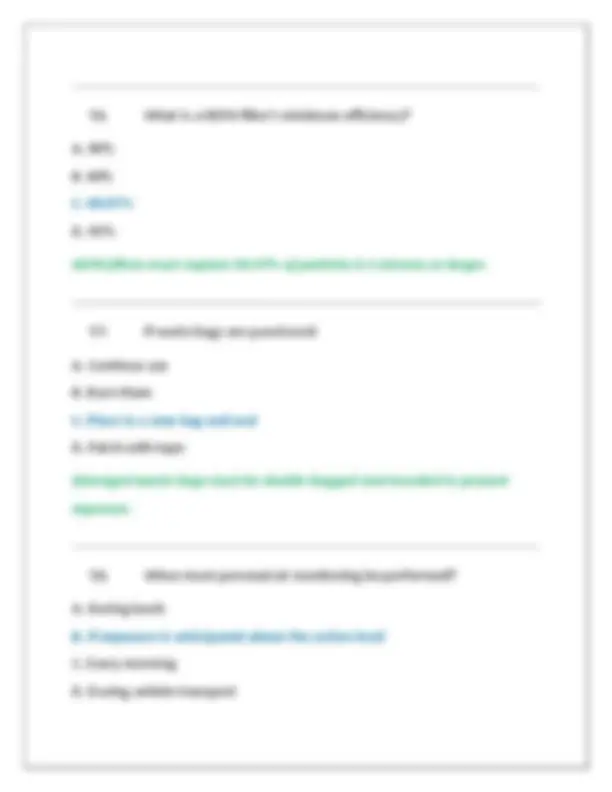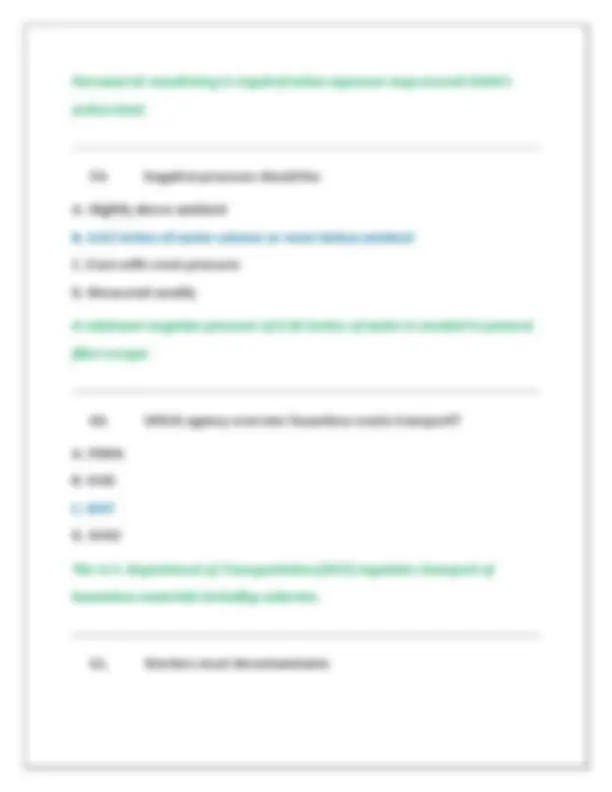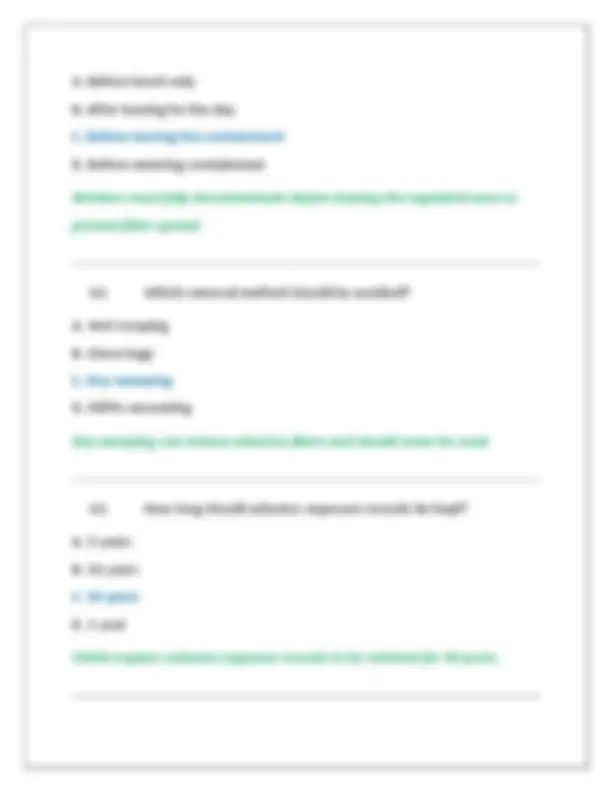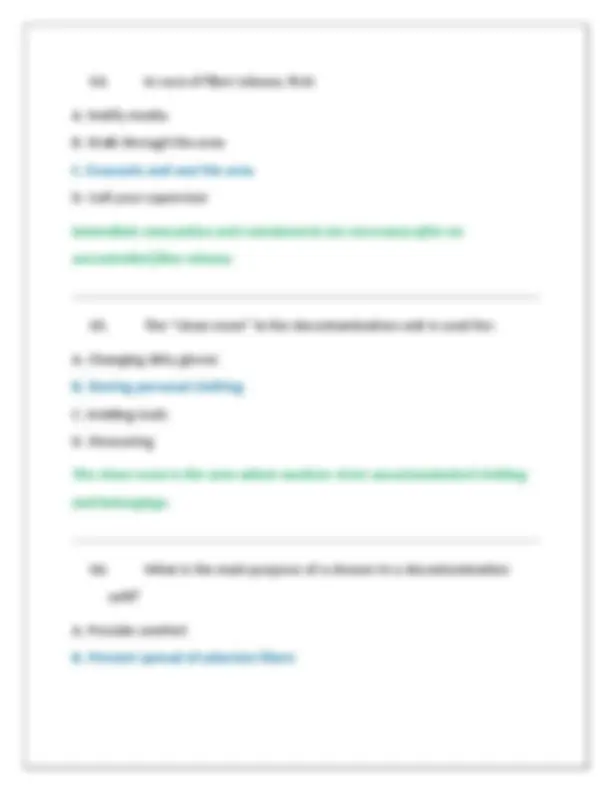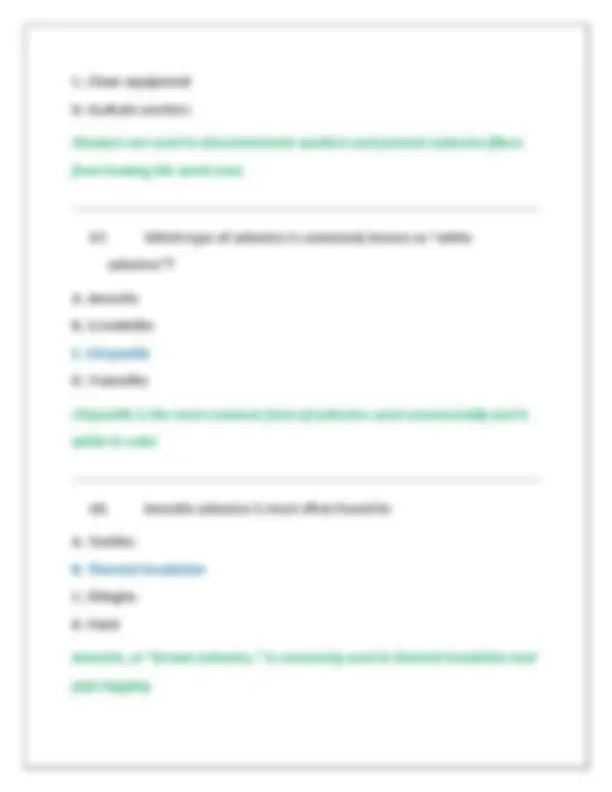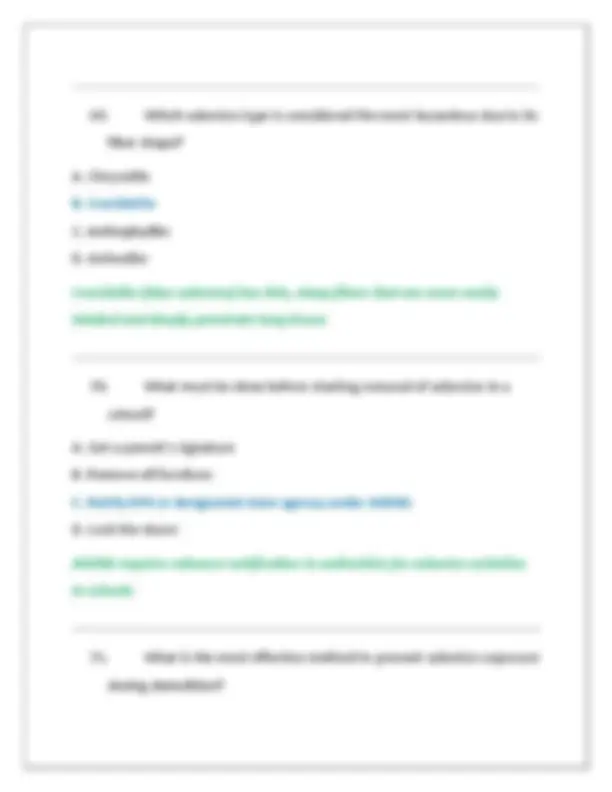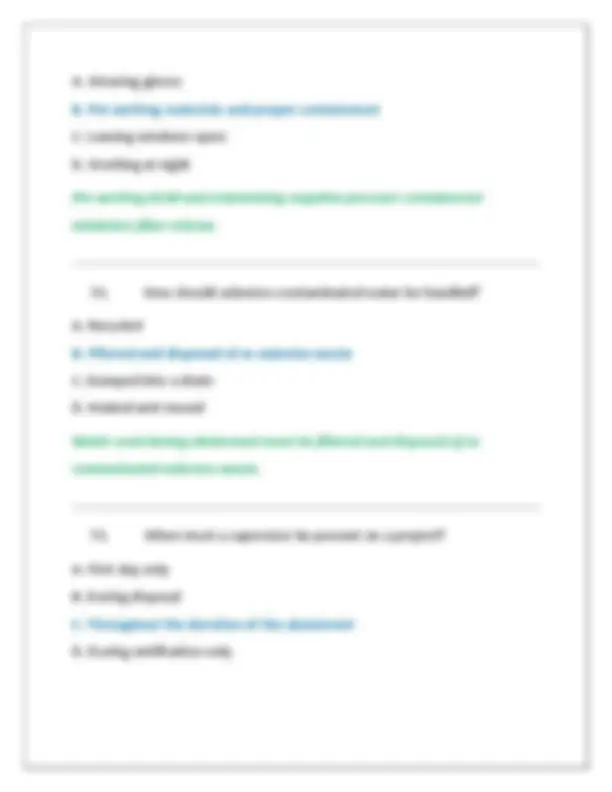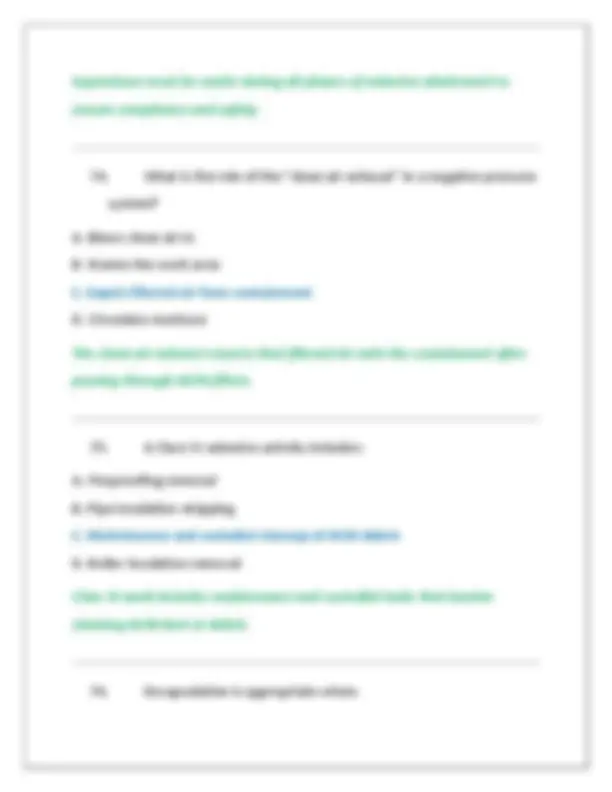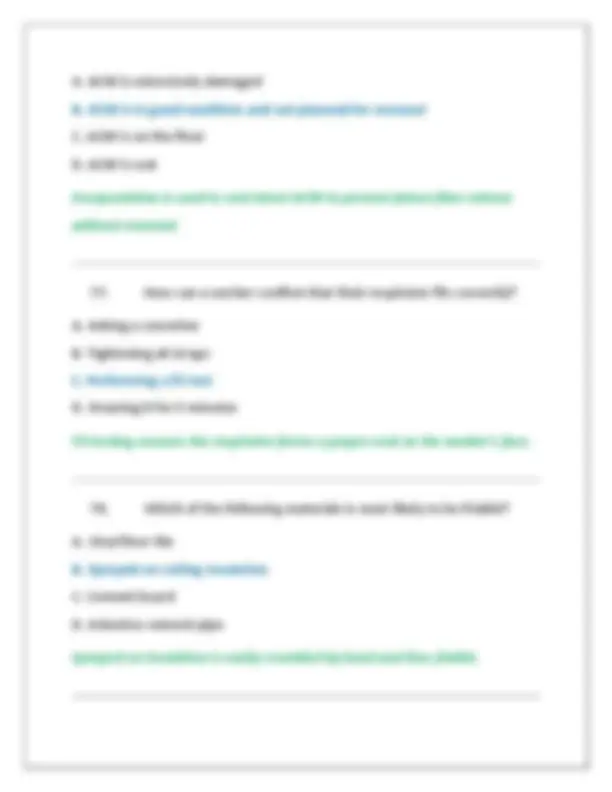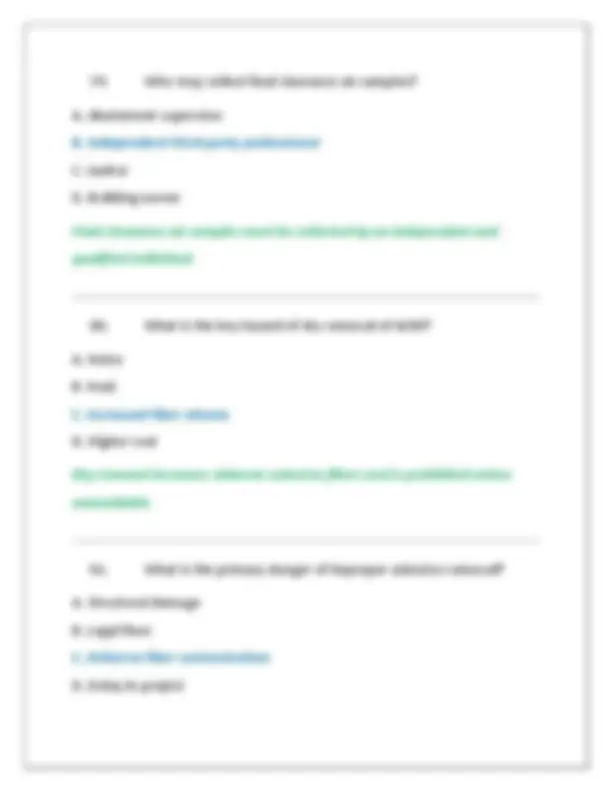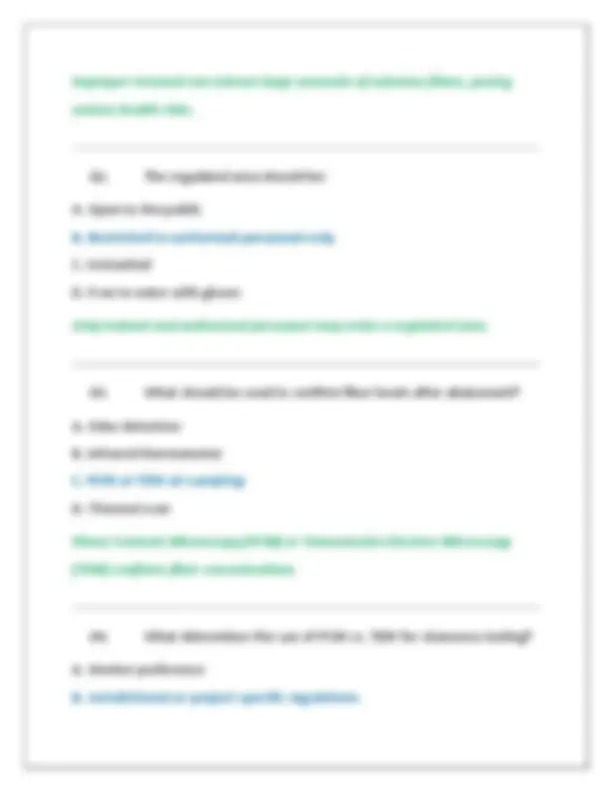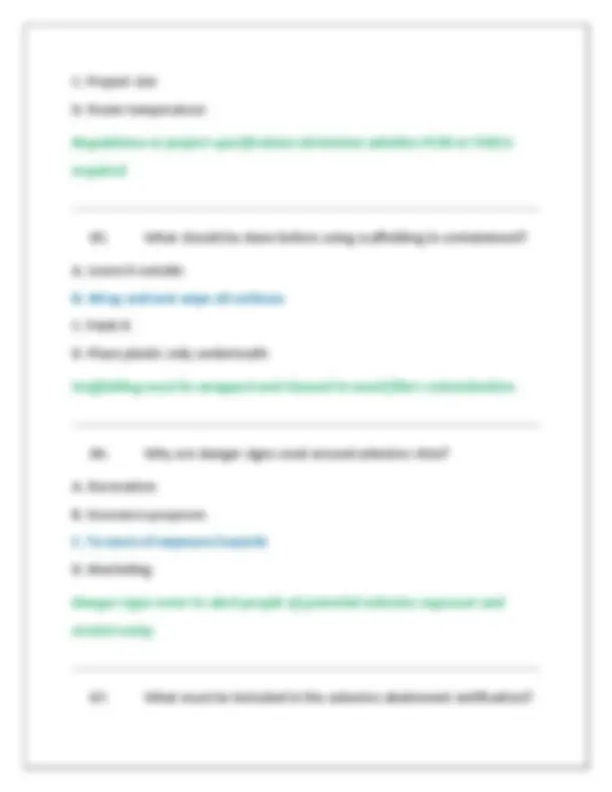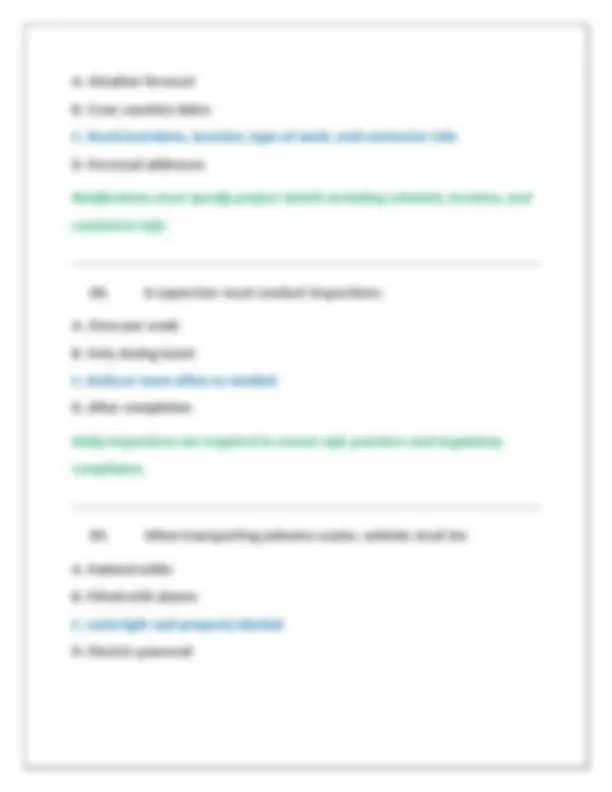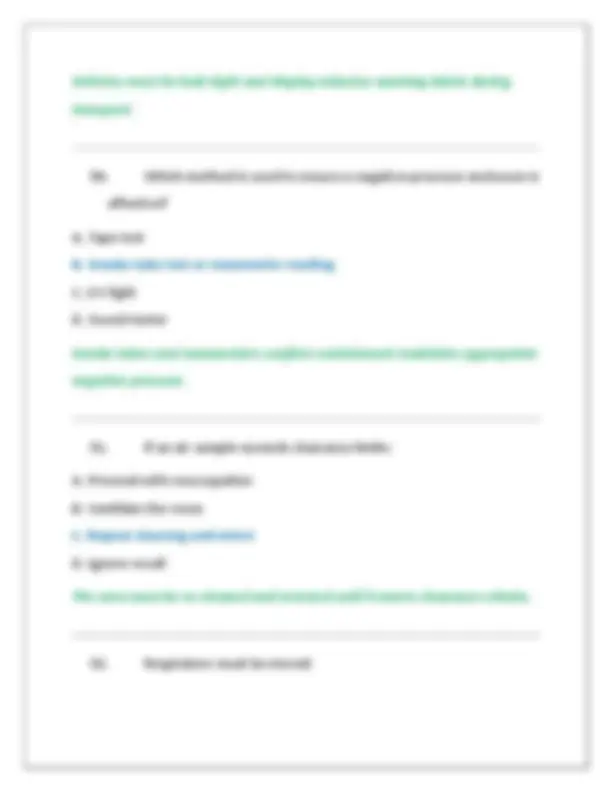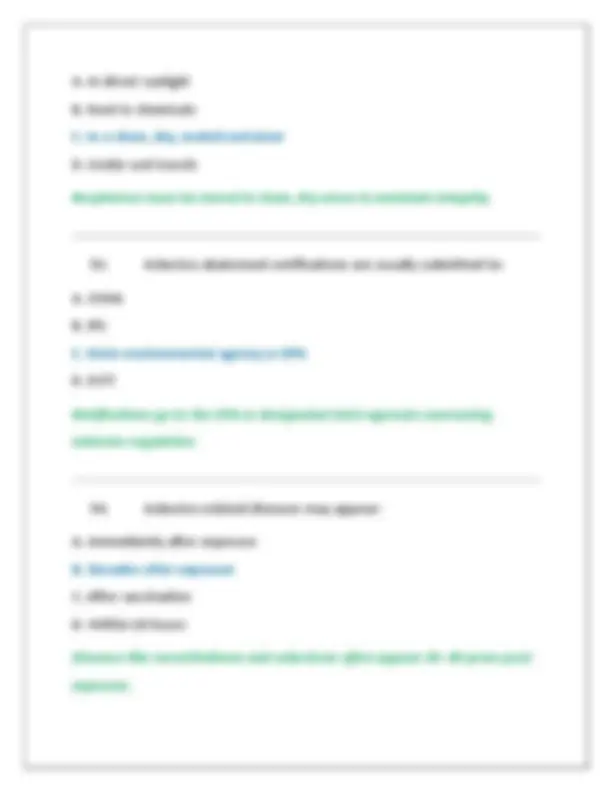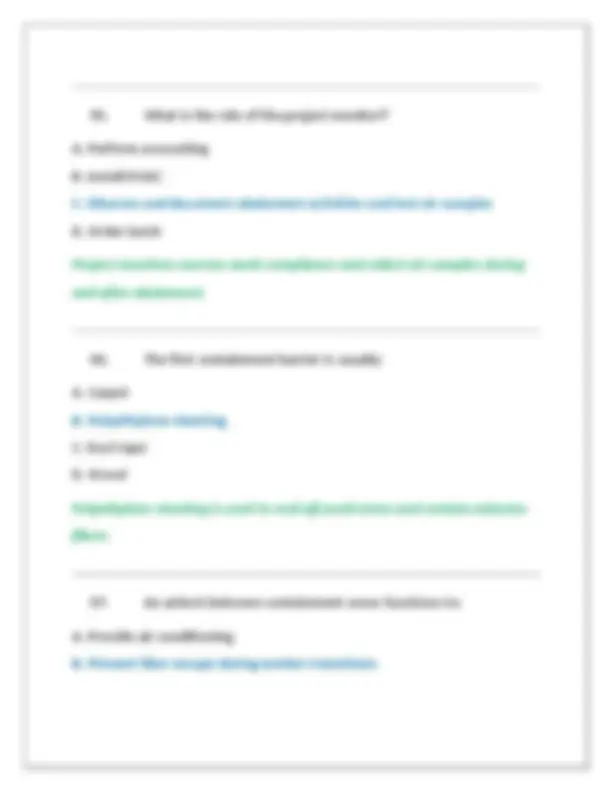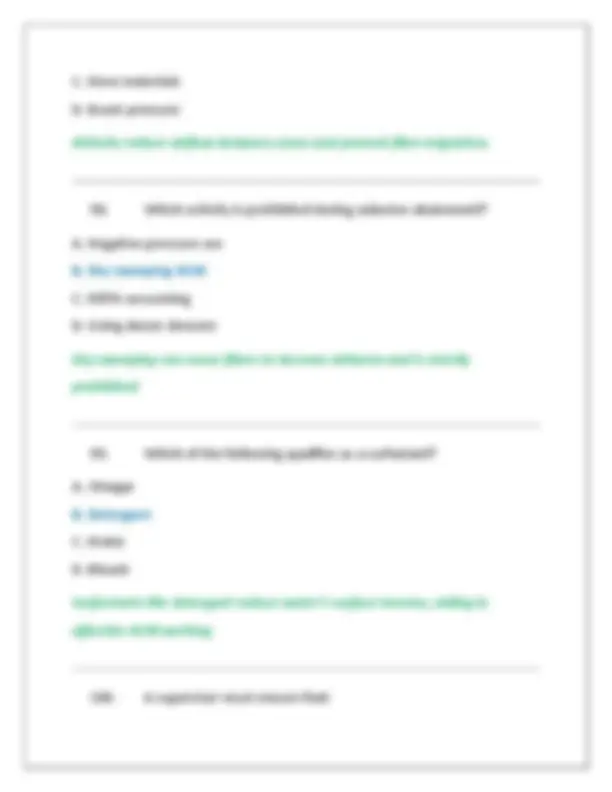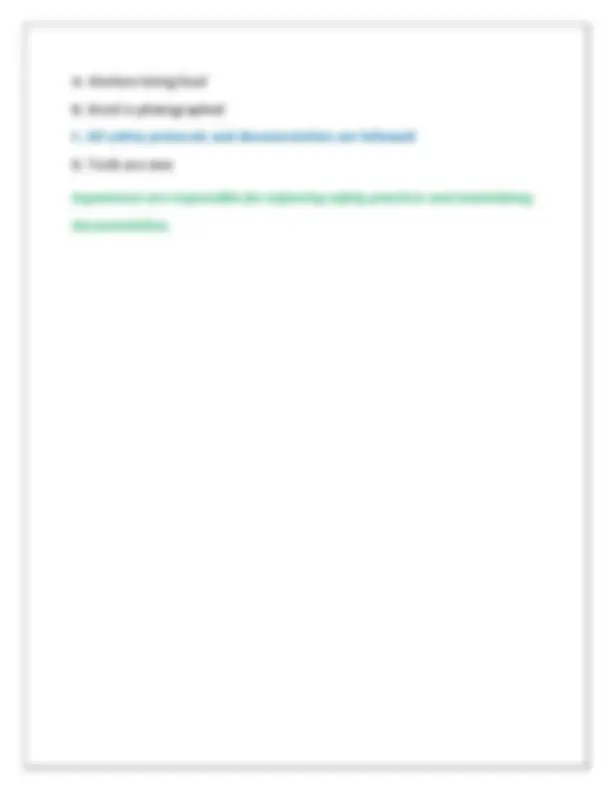Download ASBESTOS CONTRACTOR/SUPERVISOR LICENSE EXAM 2 QUESTIONS AND CORRECT ANSWERS (VERIFIED A and more Exams Environmental Engineering in PDF only on Docsity!
ASBESTOS CONTRACTOR/SUPERVISOR
LICENSE EXAM 2 QUESTIONS AND
CORRECT ANSWERS (VERIFIED
ANSWERS) PLUS RATIONALES 2025 Q&A
| INSTANT DOWNLOAD PDF
- What is the primary purpose of the Clean Air Act as it relates to asbestos? A. To regulate water discharges B. To limit airborne emissions of hazardous pollutants C. To monitor workplace injuries D. To inspect asbestos in schools The Clean Air Act authorizes the EPA to regulate airborne emissions of hazardous materials, including asbestos.
- Which agency enforces the Asbestos NESHAP regulations? A. OSHA B. EPA C. DOT D. CDC EPA enforces the National Emission Standards for Hazardous Air Pollutants (NESHAP), including asbestos regulations.
- Which of the following is a Class I asbestos abatement activity? A. Demolition of wood structures B. Repairing roofing with non-asbestos materials C. Removal of thermal system insulation (TSI) D. Painting a contaminated surface Class I work includes activities involving the removal of TSI and surfacing ACM.
- When must negative pressure enclosures be used? A. In small-scale projects only B. When asbestos levels are below the PEL C. During large-scale removal of friable ACM D. Only during final clearance
A. Begin removal immediately B. Notify neighbors C. Notify EPA/state agency and post warnings D. Apply disinfectant Notification of authorities and warning signs must be posted before starting asbestos work.
- What is the primary health hazard associated with asbestos exposure? A. Asthma B. Mesothelioma C. Skin cancer D. Liver failure Asbestos exposure is strongly linked to mesothelioma, a fatal lung-related cancer.
- Which personal protective equipment (PPE) is required for workers during asbestos abatement? A. Leather gloves B. Dust masks C. Full-face respirator and disposable suits D. Safety goggles only
A full-face respirator with HEPA filters and disposable suits are required to protect against asbestos exposure.
- What type of filter is used in respirators for asbestos? A. P B. N C. HEPA D. Charcoal HEPA (High-Efficiency Particulate Air) filters are required for asbestos due to their ability to capture fine fibers.
- Who is responsible for ensuring proper supervision and compliance at a job site? A. The building owner B. The project designer C. The licensed supervisor D. The waste transporter The licensed asbestos supervisor is responsible for site compliance and safety.
C. Increasing ventilation D. Burning the material Wet methods reduce airborne fiber release during asbestos removal.
- How often must air monitoring be done during a large asbestos project? A. Weekly B. At the end of the job C. Daily or as required by regulation D. Monthly Air monitoring ensures the environment remains safe during abatement, especially on a daily basis.
- What is glove bag technique used for? A. Large-scale ACM removal B. Small pipe insulation removal C. Spray applications D. Floor tile removal Glove bags are used for small-scale removal, especially pipe insulation.
- Decontamination units must include:
A. Drinking water station B. Equipment room, shower, and clean room C. Storage for tools D. Telephone booth A decon unit must have an equipment room, a shower, and a clean room to avoid contamination.
- What is a clearance air test? A. A check on HVAC efficiency B. A test to verify safe fiber levels post-abatement C. A random EPA audit D. A respiratory fit test Clearance air testing confirms fiber levels are below acceptable limits after work is completed.
- How should asbestos debris be disposed of? A. In plastic bags in regular trash B. Flushed down a drain C. In sealed, labeled containers at approved landfills D. Burned on-site
A. 8-hour awareness B. 40-hour EPA-approved supervisor course C. Online orientation D. First aid training only Supervisors must complete a 40-hour accredited asbestos contractor/supervisor course.
- The main federal regulation governing asbestos in schools is: A. OSHA 1910 B. AHERA C. CERCLA D. RCRA The Asbestos Hazard Emergency Response Act (AHERA) applies specifically to schools.
- Who conducts final visual inspection after abatement? A. The building owner B. The contractor C. The project monitor or competent person D. Waste transporter The project monitor performs visual inspection before clearance testing.
- A HEPA vacuum should be used to: A. Blow away fibers B. Remove fine asbestos dust safely C. Clean carpets D. Scrub floors Only HEPA vacuums can safely remove asbestos particles without dispersing them.
- What is the required number of air changes per hour (ACH) for negative pressure enclosures? A. 2 B. 8 C. 4 D. 10 Negative pressure enclosures must maintain at least 4 air changes per hour to control fiber levels.
- The function of the manometer during abatement is to: A. Record temperature B. Test humidity
A. AHERA
B. OSHA 29 CFR 1926.
C. TSCA
D. DOT CFR 49
OSHA 29 CFR 1926.1101 governs asbestos safety in construction work, including exposure limits.
- Before using a respirator, a worker must: A. Sign a waiver B. Undergo medical evaluation C. Fill out a logbook D. Submit their resume Medical evaluations are required to ensure workers are physically fit to wear respirators.
- Asbestos waste containers must be: A. Cardboard only B. Leak-tight and labeled C. Ventilated D. Reusable
Containers must be leak-tight and clearly labeled as containing asbestos waste.
- The purpose of the final visual inspection is to: A. Save on testing costs B. Ensure no visible debris remains before air testing C. Replace air monitoring D. Evaluate noise levels The final visual ensures the work area is visibly clean before clearance testing.
- A competent person is required to: A. Inspect only once B. Be on-call during work C. Be present and conduct frequent inspections D. Only review reports A competent person must oversee and regularly inspect asbestos abatement operations.
- Which of the following must be posted at the worksite?
OSHA enforces worker safety standards including those for asbestos.
- Asbestos fibers are most dangerous when: A. Sealed B. Encapsulated C. Airborne D. Painted Airborne asbestos fibers pose the greatest risk as they can be inhaled and lodged in lung tissue.
- When should glove bags be discarded? A. When filled with water B. After 24 hours C. Immediately after single use D. After final clearance Glove bags are designed for single use and should be discarded after removal.
- The minimum number of decontamination stages required is: A. 1 B. 3
C. 5
D. 2
A three-stage decontamination unit includes equipment room, shower, and clean room.
- What is the best method to control dust during removal? A. Sanding B. Brushing C. Amended water application D. Sweeping Amended water (with surfactant) helps saturate ACM and reduces dust release.
- How should asbestos-contaminated tools be cleaned? A. Compressed air B. Tap water C. HEPA vacuum and wet wiping D. Dry cloth Tools should be cleaned using HEPA vacuums and wet wipes to avoid releasing fibers.
Category II non-friable materials include products like cement siding that don't crumble easily.
- What’s the purpose of a viewing window in a containment? A. Let in light B. Allow visual inspection without entry C. Provide airflow D. Allow communication Viewing windows help supervisors and inspectors monitor work without breaching containment.
- Which of the following is NOT a safe disposal practice? A. Wetting debris B. Double bagging in labeled plastic C. Disposing in regular trash** D. Using lined drums Asbestos must never be disposed of in general trash—only at approved facilities.
- The action level for asbestos exposure is:
A. 1.0 f/cc B. 0.1 f/cc averaged over 8 hours C. 0.5 f/cc averaged over 1 hour D. 0.8 f/cc peak The OSHA action level is 0.1 fibers/cc averaged over 8 hours, triggering additional requirements.
- Which entity certifies asbestos training providers? A. CDC B. EPA or state regulatory agencies C. DOT D. FEMA EPA or state programs must accredit training providers for asbestos professionals.
- What does PACM stand for? A. Partial ACM B. Presumed Asbestos-Containing Material C. Personal ACM D. Pre-tested ACM

